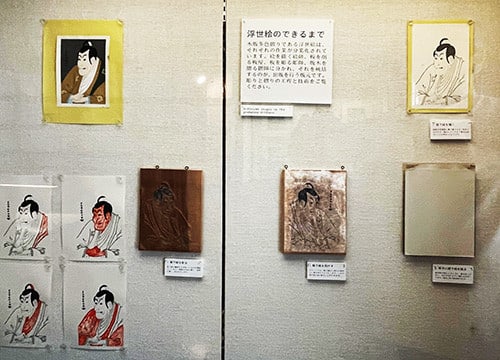



浮世絵という表現形式を得て、日本の出版文化は実質的に産声を上げた。それまでの日本美術とは宗教寺院や支配層への奉仕が主たる生存形式であって、狩野派などの絵画制作集団はときの権力機構などに寄生してその維持を図ってきた存在だった。狩野派は権力者の城郭襖絵などの「公共建築需要」を受注落札する専門的集団であって一種の美術版ゼネコン的存在だったと思える。また「鎌倉殿の13人」でも登場した運慶はあのように権力に取り入ることで創作の機会を得てきていた。わたしがいちばん好きな日本画「風神雷神図」俵屋宗達作品は京都の名刹寺院からの注文製作だった。そのようなひとつの伝統的ジャンルとして「洛中洛外図屏風絵」があって、国宝に指定されているのが舟木本・岩佐又兵衛筆作品。かれがこのジャンルの集大成作品を生み出した後、活躍の舞台を京都から江戸に移して、浮世絵文化への橋渡し役を果たしたと言われている。
日本絵画は京都が主流だった時代には画題テーマは宗教であったり、王朝文学の背景画であったり、障壁画などであったものが、江戸では浮世絵文化の勃興とともに画題がビッグバンして、市井の名所図会・役者絵・美人画と直接的な大衆の興味分野にシフトしていった。まさに「芸術の大衆化」だった。
個人的な思いかも知れないけれど芸術家というのは日本では余技として描いた作品の方が多くの人に愛されているのではないだろうか。わたしは俵屋宗達と、岩佐又兵衛に強く惹かれているけれど、どうも専業画家というよりも別に生計を立てていて、画業は余技というスタイルが、むしろ民衆のこころには響くなにごとかがあるのではないかと思っている。俵屋宗達は扇の専門店を経営していたと言われる。キャンバスに向かう心理に於いて自由さがあって、制作するこころに狭量を感じないということではないか。

今日、メディアは大きな転換期に差し掛かっている。WEBによる既存メディアの革新は留まるところを知らないけれど、一方で個人の価値感世界だけを押しつけるような動画などは早くも壁に突き当たり始めてきている。いわゆるYouTUberの停滞・行き詰まりが指摘されてきている。ある特定個人の言説だけを信奉し依存するというのではまるで新興宗教のようでそれはやはり危険性が高い。公平性・客観性という価値感はやはり不可欠な情報要素なのだと思う。メディアは情報の公平な「広場」機能であるべきで、最終的判断は情報の受けてが自己判断できるその材料を提供するのが本来の使命だろう。
そんな時代の中で、浮世絵という日本社会が経験してきたニューメディアの興亡ぶりから今日学ぶべきことも多いのではないか。歴史からいろいろな真実を汲み取って活かしていく必要があるのでしょう。
English version⬇
The Development and Rise and Fall of the Media, Ukiyoe-4: Edo Period, Boso Machiya-13
Today's media are in a state of confusion. There are many things to be learned from the historical transition of Ukiyo-e with an open mind. ...
With the acquisition of ukiyoe as a form of expression, Japan's publishing culture was practically born. Until then, Japanese art had mainly existed as a service to religious temples and the ruling class, and painting groups such as the Kano school were parasites on the power structure of the time in order to maintain their existence. The Kano school was a group that specialized in bidding for "public building needs," such as sliding door paintings of castles for powerful people, and it seems to have been a kind of art version of a general contractor. Unkei, who also appeared in "The Thirteen of Kamakura-dono," had the opportunity to create works by taking advantage of the power of the authorities. My favorite Japanese painting, "The Wind and Thunder Gods," by Sotatsu Tawaraya, was commissioned by a famous temple in Kyoto. One such traditional genre is "Rakuchu Rakugai-zu Byobu-e," and the Funaki version, by Iwasa Matabei, is designated a national treasure. After he created the culmination of this genre, he moved the stage of his activities from Kyoto to Edo, where he is said to have served as a bridge to the Ukiyoe culture.
In the Kyoto period when Japanese painting was the mainstream, the themes of paintings were religion, backgrounds of imperial literature, and barrier paintings, etc. In Edo, however, with the emergence of the ukiyo-e culture, the themes of paintings were in a big bang and shifted directly to areas of popular interest, such as cityscapes, portraits of actors and beauties, etc. It was truly a "popularization of art. It was truly the "popularization of art.
It may be my personal opinion, but I think that artists in Japan are more loved for the works they created as an afterthought. I am strongly attracted to Sotatsu Tawaraya and Matabei Iwasa, but I think that the style of artists who earn their living separately and do painting as an afterthought rather than as full-time painters may have something that resonates with the public. Tawaraya Sotatsu is said to have operated a store specializing in fans. I think that this indicates that there is a freedom in the mind that goes into the canvas, and that there is no sense of narrowness in the mind of the creator.
Today, the media is approaching a major turning point, and while there is no end in sight to the innovation of existing media via the Web, videos and other media that impose only personal values are already beginning to hit a wall. The so-called "YouTuber" has reached a plateau and a dead end. Belief in and dependence on a particular individual's discourse is like a new religion, which is also highly dangerous. I believe that the values of fairness and objectivity are indispensable elements of information. The media should function as an impartial "forum" for information, and its original mission should be to provide information that enables the recipient of information to make a final judgment on his or her own.
In such an era, there are many lessons to be learned from the rise and fall of new media such as Ukiyo-e, which Japanese society has experienced. It is probably necessary to take various truths from history and make use of them.



















